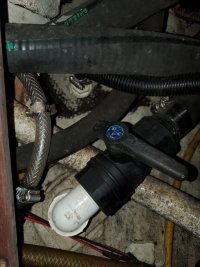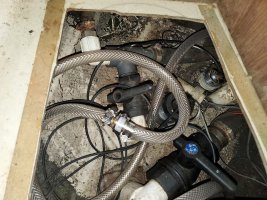Been doing some reading in other threads, and found some similar from back in 2006 and 2008. Would like to see if anyone has any new enlightenments on the topic.
When I pull the boat out this Spring, one task I'm going to take into consideration is replacing through-hulls. They're all original, so I'm not sure what I can trust and what I can't. Many of the seacocks haven't been exercised in years, so I'm afraid to even touch them right now.
Specifically, what should I do with the waste discharge through-hull and seacock? Being on a lake in Kansas, discharging overboard will never be an option. Is it better to remove the old seacock and through-hull, glass it over, and be done with it? Others have removed the hoses and put a plug in, but that still assumes the through-hull is going to hold. Replacing it with new certainly doesn't seem like a good long-term choice, since I have no intention of using it. But, maybe that's the easiest (I currently have zero fiberglass skills). Removing it would certainly reduce the connections by the waste tank.
Honestly, I'd like to remove the whole setup and replace it with a composting head, but I need the $850 for other things my first season of ownership. The head still works, as far as I know, and was replaced in the last 10-ish years. And while the thought of pumping out the waste tank with some frequency and cleaning/winterizing it every year doesn't thrill me, I'm willing to do at least that to put the money to other projects.
Appreciate your thoughts and experience on this. Especially those who might have done something like this years ago. Any regrets?
When I pull the boat out this Spring, one task I'm going to take into consideration is replacing through-hulls. They're all original, so I'm not sure what I can trust and what I can't. Many of the seacocks haven't been exercised in years, so I'm afraid to even touch them right now.
Specifically, what should I do with the waste discharge through-hull and seacock? Being on a lake in Kansas, discharging overboard will never be an option. Is it better to remove the old seacock and through-hull, glass it over, and be done with it? Others have removed the hoses and put a plug in, but that still assumes the through-hull is going to hold. Replacing it with new certainly doesn't seem like a good long-term choice, since I have no intention of using it. But, maybe that's the easiest (I currently have zero fiberglass skills). Removing it would certainly reduce the connections by the waste tank.
Honestly, I'd like to remove the whole setup and replace it with a composting head, but I need the $850 for other things my first season of ownership. The head still works, as far as I know, and was replaced in the last 10-ish years. And while the thought of pumping out the waste tank with some frequency and cleaning/winterizing it every year doesn't thrill me, I'm willing to do at least that to put the money to other projects.
Appreciate your thoughts and experience on this. Especially those who might have done something like this years ago. Any regrets?
Last edited:





